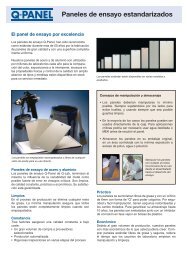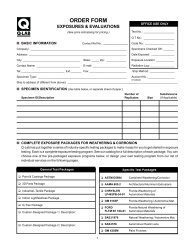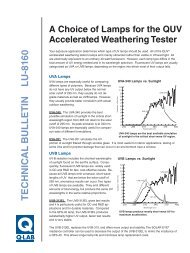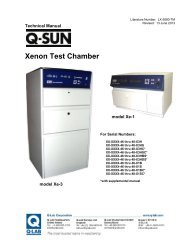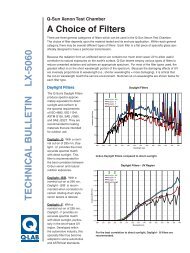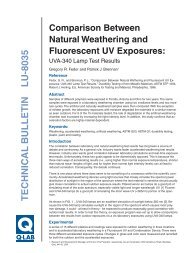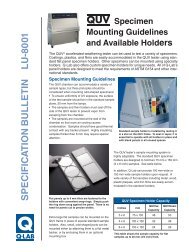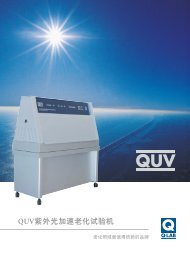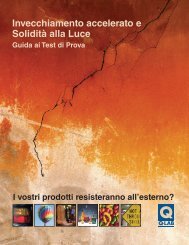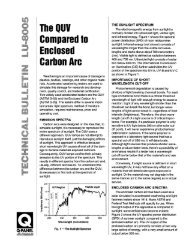LU-8031 - High Irradiance UV Testers - Q-Lab
LU-8031 - High Irradiance UV Testers - Q-Lab
LU-8031 - High Irradiance UV Testers - Q-Lab
You also want an ePaper? Increase the reach of your titles
YUMPU automatically turns print PDFs into web optimized ePapers that Google loves.
TECHNICAL BULLETIN <strong>LU</strong>-<strong>8031</strong><br />
<strong>High</strong> <strong>Irradiance</strong><br />
<strong>UV</strong>/Condensation <strong>Testers</strong><br />
Allow Faster Accelerated<br />
Weathering Test Results<br />
Introduction & Background<br />
Weatherability is a necessary quality for coatings<br />
used outdoors. Because outdoor exposures<br />
are so time consuming, accelerated<br />
laboratory testing is used extensively by<br />
industry. One of the more popular laboratory<br />
weathering testers is the ASTM G53 <strong>UV</strong>/Condensation<br />
device, also known as the Q<strong>UV</strong>. 1<br />
In the Q<strong>UV</strong>, test specimens are repetitively<br />
exposed to alternating cycles of <strong>UV</strong> light and<br />
condensing moisture at controlled temperatures.<br />
Previously, exposure conditions could be<br />
varied only by the selection of the fluorescent<br />
<strong>UV</strong> lamp, the timing of the <strong>UV</strong> and condensation<br />
exposures and the temperatures of the exposures.<br />
This paper examines an enhancement<br />
to the Q<strong>UV</strong> weathering tester for precise control<br />
of light output and higher irradiance. Data is<br />
presented on the accelerating effect of higher<br />
irradiance on several common polymers.<br />
<strong>Irradiance</strong> Control System<br />
The irradiance control system, marketed under<br />
the name “Solar Eye,” consists of a programmable<br />
controller that continuously monitors the<br />
<strong>UV</strong> intensity via four sensors mounted in the<br />
test sample plane. A four channel feedback loop<br />
system maintains the programmed irradiance<br />
level by adjusting power to <strong>UV</strong> lamps. The irradiance<br />
level can be adjusted to varying intensities<br />
for different applications. Figure 1 shows<br />
a simplified schematic of how the irradiance<br />
control system works.<br />
Each sensor monitors the intensity of two<br />
lamps. Each sensor is individually calibrated<br />
Figure 1<br />
<br />
1<br />
Sample<br />
Plane<br />
Ballast 1<br />
Controller<br />
Ballast <br />
Lamps<br />
(all same age)<br />
Detector<br />
Sample<br />
Plane<br />
by the operator on a regular basis. The calibration<br />
is traceable to the National Institute of<br />
Standards and Technology (NIST) for ISO 9000<br />
compliance.<br />
Data presented previously 2 has shown that the<br />
Solar Eye control system largely eliminates<br />
variations in <strong>UV</strong> intensity and therefore greatly<br />
reduces variations in test results.<br />
Ballast 4<br />
Ballast 3<br />
3<br />
4<br />
1. ASTM G53, Standard Practice for Operating Light and Water Exposure Apparatus (Fluorescent <strong>UV</strong>-Condensation Type) for Exposure of<br />
Nonmetalic Materials, Annual Book of ASTM Standards, Vol. 04.07, American Society for Testing and Materials, Philadelphia, 1992.<br />
2. Fedor, G. R., Brennan, P. J., “<strong>Irradiance</strong> Control In Fluorescent <strong>UV</strong> Exposure <strong>Testers</strong>,” Accelerated and Outdoor Durability Testing of Organic<br />
Materials, ASTM STP 1202, Warren D. Ketola, and Douglas Grossman, Eds., American Society for Testing and Materials, Philadelphia, 1993.
<strong>High</strong> <strong>Irradiance</strong> for Faster Results<br />
The programmable, automatic irradiance control<br />
system allows the operator to choose a higher than<br />
standard level of irradiance for <strong>UV</strong> exposure tests.<br />
For many materials, this results in faster degradation<br />
and therefore shorter test times.<br />
It is widely recognized the <strong>UV</strong>A-340 lamp is a more<br />
realistic simulation of sunlight than the <strong>UV</strong>B-313<br />
lamp. 3,4 Since its introduction, most of the plastics<br />
industry has switched to the <strong>UV</strong>A-340 because it<br />
gives more realistic results. However, in spite of its<br />
limitations, a large number of coatings researchers<br />
continue to use the <strong>UV</strong>-B lamps because they give<br />
faster results. With the programmable controller,<br />
the <strong>UV</strong>A-340 can now be operated at higher irradiance<br />
levels to speed up test results. Figure 2<br />
shows <strong>UV</strong>A-340 lamps at various irradiance levels,<br />
compared to sunlight.<br />
The recommended maximum increase over typical<br />
G53 irradiance is 75%. Even though lamps are<br />
capable of higher intensity levels at full power, it is<br />
not recommended that tests be run at levels higher<br />
than 1.75x normal. There must be some excess<br />
power available to maintain the desired set point<br />
and account for such things as lamp aging and other<br />
factors which reduce the maximum irradiance<br />
potential. It should be noted that lamps operated at<br />
higher than normal irradiance will have a proportionally<br />
shorter useful life span.<br />
Exposure Results for Various<br />
Polymers<br />
The programmable, automatic irradiance control<br />
system allows the operator to choose a higher than<br />
standard level of irradiance for <strong>UV</strong> exposure tests.<br />
For many materials, this results in faster degradation<br />
and therefore shorter test times.<br />
It is widely recognized the <strong>UV</strong>A-340 lamp is a more<br />
realistic simulation of sunlight than the <strong>UV</strong>B-313<br />
lamp. 3,4 Since its introduction, most of the plastics<br />
industry has switched to the <strong>UV</strong>A-340 because it<br />
gives more realistic results. However, in spite of its<br />
limitations, a large number of coatings researchers<br />
continue to use the <strong>UV</strong>-B lamps because they give<br />
faster results. With the programmable controller,<br />
the <strong>UV</strong>A-340 can now be operated at higher irradiance<br />
levels to speed up test results. Figure 2<br />
shows <strong>UV</strong>A-340 lamps at various irradiance levels,<br />
compared to sunlight.<br />
The recommended maximum increase over typical<br />
G53 irradiance is 75%. Even though lamps are<br />
capable of higher intensity levels at full power, it is<br />
not recommended that tests be run at levels higher<br />
than 1.75x normal. There must be some excess<br />
power available to maintain the desired set point<br />
and account for such things as lamp aging and other<br />
factors which reduce the maximum irradiance<br />
potential. It should be noted that lamps operated at<br />
higher than normal irradiance will have a proportionally<br />
shorter useful life span.<br />
Figure 2 Figure 3<br />
<strong>UV</strong>A-340 at Different Intensities<br />
Acrylic Yellowing<br />
<strong>Irradiance</strong> W/m /nm<br />
1.5<br />
1<br />
0.5<br />
Intensified<br />
1.75x<br />
<strong>UV</strong>A-340<br />
Typical <strong>Irradiance</strong><br />
Reduced to .35<br />
Noon Summer<br />
Sunlight<br />
Gloss<br />
100<br />
80<br />
60<br />
40<br />
20<br />
0.83<br />
Material: Epoxy Coating (gray)<br />
Test Conditions:<br />
Q<strong>UV</strong>/se<br />
Lamp: <strong>UV</strong>A-340<br />
<strong>Irradiance</strong>: 1.35 & 0.83 W/m2/nm @ 340nm<br />
Cycle: <strong>UV</strong> Only<br />
Temperature: B.P. 50C<br />
0<br />
270 290 310 330 350 370 390<br />
Wavelength (nm)<br />
1.3<br />
0<br />
0 500 1000 1500 2000 2500<br />
Hours Q<strong>UV</strong>/se Exposure
Figure 4<br />
Acrylic Yellowing<br />
delta b<br />
10<br />
9<br />
8<br />
7<br />
6<br />
5<br />
4<br />
3<br />
Material: Acrylic Sheet (clear)<br />
2<br />
1.3<br />
1<br />
0.83<br />
0<br />
0 500 1000 1500 2000 2500<br />
Hours Q<strong>UV</strong>/se Exposure<br />
Test Conditions:<br />
Q<strong>UV</strong>/se<br />
Lamp: <strong>UV</strong>A-340<br />
<strong>Irradiance</strong>: 1.35 & 0.83 W/m2/nm @ 340nm<br />
Cycle: <strong>UV</strong> Only<br />
Temperature: B.P. 50C<br />
Figure 8<br />
Acrylic Yellowing<br />
delta b<br />
0.0<br />
-0.2<br />
-0.4<br />
-0.6<br />
Material: Vinyl Film (green)<br />
Test Conditions:<br />
Q<strong>UV</strong>/se<br />
Lamp: <strong>UV</strong>A-340<br />
<strong>Irradiance</strong>: 1.35 & 0.83 W/m2/nm @ 340nm<br />
Cycle: <strong>UV</strong> Only<br />
Temperature: B.P. 50C<br />
1.3<br />
-0.8<br />
0 500 1000 1500 2000 2500<br />
Hours Q<strong>UV</strong>/se Exposure<br />
0.83<br />
Figure 5<br />
Polystyrene Yellowing<br />
Figure 9<br />
Vinyl Yellowing<br />
50<br />
40<br />
1.3<br />
0.83<br />
30<br />
Material:<br />
Polycarbonate Sheet (clear)<br />
1.3<br />
delta b<br />
30<br />
Material:<br />
20<br />
Polystyrene Reference Matl. (clear)<br />
Test Conditions:<br />
Q<strong>UV</strong>/se<br />
Lamp: <strong>UV</strong>A-340<br />
10<br />
<strong>Irradiance</strong>: 1.35 & 0.83 W/m2/nm @ 340nm<br />
Cycle: <strong>UV</strong> Only<br />
Temperature: B.P. 50C<br />
0<br />
0 500 1000 1500 2000 2500<br />
Hours Q<strong>UV</strong>/se Exposure<br />
delta b<br />
20<br />
10<br />
Test Conditions:<br />
Q<strong>UV</strong>/se<br />
Lamp: <strong>UV</strong>A-340<br />
<strong>Irradiance</strong>: 1.35 & 0.83 W/m2/nm @ 340nm<br />
Cycle: <strong>UV</strong> Only<br />
Temperature: B.P. 50C<br />
0<br />
0 500 1000 1500 2000 2500<br />
Hours Q<strong>UV</strong>/se Exposure<br />
0.83<br />
Figure 6<br />
Vinyl Yellowing<br />
Figure 10<br />
Polycarbonate Yellowing<br />
50<br />
30<br />
Material: P.V.C. Film (clear)<br />
1.3<br />
50<br />
40<br />
Material: CAB Sheet (clear)<br />
1.3<br />
delta b<br />
20<br />
10<br />
Test Conditions:<br />
Q<strong>UV</strong>/se<br />
Lamp: <strong>UV</strong>A-340<br />
<strong>Irradiance</strong>: 1.35 & 0.83 W/m2/nm @ 340nm<br />
Cycle: <strong>UV</strong> Only<br />
Temperature: B.P. 50C<br />
0<br />
0 500 1000 1500 2000 2500<br />
Hours Q<strong>UV</strong>/se Exposure<br />
0.83<br />
delta b<br />
30<br />
20<br />
Test Conditions:<br />
Q<strong>UV</strong>/se<br />
Lamp: <strong>UV</strong>A-340<br />
10<br />
<strong>Irradiance</strong>: 1.35 & 0.83 W/m2/nm @ 340nm<br />
Cycle: <strong>UV</strong> Only<br />
Temperature: B.P. 50C<br />
0<br />
0 500 1000 1500 2000 2500<br />
Hours Q<strong>UV</strong>/se Exposure<br />
0.83<br />
Figure 7<br />
Vinyl Gloss Loss<br />
Gloss<br />
100<br />
90<br />
80<br />
70<br />
60<br />
50<br />
40<br />
30<br />
20<br />
10<br />
Material: Acrylic Sheet (clear)<br />
Test Conditions:<br />
Q<strong>UV</strong>/se<br />
Lamp: <strong>UV</strong>A-340<br />
<strong>Irradiance</strong>: 1.35 & 0.83 W/m2/nm @ 340nm<br />
Cycle: <strong>UV</strong> Only<br />
Temperature: B.P. 50C<br />
0<br />
0 500 1000 1500 2000 2500<br />
Hours Q<strong>UV</strong>/se Exposure<br />
0.83<br />
1.3<br />
Figure 11<br />
Polyester<br />
Gloss<br />
100<br />
90<br />
80<br />
70<br />
60<br />
50<br />
40<br />
30<br />
20<br />
10<br />
Material: Polyester Coating (tan)<br />
Test Conditions:<br />
Q<strong>UV</strong>/se<br />
Lamp: <strong>UV</strong>A-340<br />
<strong>Irradiance</strong>: 1.35 & 0.83 W/m2/nm @ 340nm<br />
Cycle: <strong>UV</strong> Only<br />
Temperature: B.P. 50C<br />
0<br />
0 500 1000 1500 2000 2500<br />
Hours Q<strong>UV</strong>/se Exposure<br />
0.83<br />
1.3
Figure 12<br />
Urethane Gloss Loss<br />
Gloss<br />
delta b<br />
100<br />
90<br />
80<br />
70<br />
60<br />
50<br />
40<br />
30<br />
20<br />
10<br />
Material: Urethane Coating (gray)<br />
Test Conditions:<br />
Q<strong>UV</strong>/se<br />
Lamp: <strong>UV</strong>A-340<br />
<strong>Irradiance</strong>: 1.35 & 0.83 W/m2/nm @ 340nm<br />
Cycle: <strong>UV</strong> Only<br />
Temperature: B.P. 50C<br />
1.3<br />
0<br />
0 500 1000 1500 2000 2500<br />
Figure 13<br />
Yellowing<br />
50<br />
40<br />
30<br />
Hours Q<strong>UV</strong>/se Exposure<br />
Material: ABS Sheet (white)<br />
0.83<br />
0.83<br />
20<br />
Test Conditions:<br />
Q<strong>UV</strong>/se<br />
Lamp: <strong>UV</strong>A-340<br />
10<br />
<strong>Irradiance</strong>: 1.35 & 0.83 W/m2/nm @ 340nm<br />
Cycle: <strong>UV</strong> Only<br />
Temperature: B.P. 50C<br />
0<br />
0 500 1000 1500 2000 2500<br />
Figure 14<br />
Hours Q<strong>UV</strong>/se Exposure<br />
Polystyrene Yellowing<br />
1.3<br />
Figure 16<br />
Polypropylene Yellowing<br />
delta b<br />
12<br />
10<br />
8<br />
6<br />
4<br />
Test Conditions:<br />
Q<strong>UV</strong>/se<br />
Lamp: <strong>UV</strong>A-340<br />
2<br />
<strong>Irradiance</strong>: 1.35 & 0.83 W/m2/nm @ 340nm<br />
Cycle: <strong>UV</strong> Only<br />
Temperature: B.P. 50C<br />
0<br />
0 500 1000 1500 2000 2500<br />
Figure 17<br />
Material: Polypropylene Sheet<br />
1.3<br />
Hours Q<strong>UV</strong>/se Exposure<br />
Automotive Paint Gloss Loss<br />
Gloss<br />
100<br />
80<br />
60<br />
40<br />
0.83<br />
Test Conditions:<br />
Q<strong>UV</strong>/se<br />
Lamp: <strong>UV</strong>A-340<br />
20<br />
<strong>Irradiance</strong>: 1.35 & 0.83 W/m2/nm @ 340nm<br />
Cycle: <strong>UV</strong> Only<br />
Temperature: B.P. 50C<br />
0<br />
0 500 1000 1500 2000 2500<br />
Hours Q<strong>UV</strong>/se Exposure<br />
0.83<br />
Material: Automotive Coating (blue/gray)<br />
1.3<br />
0<br />
Material: Polyesthylene Sheet<br />
Effect of Moisture<br />
<br />
delta b<br />
delta b<br />
-1<br />
-2<br />
Test Conditions:<br />
-3<br />
Q<strong>UV</strong>/se<br />
Lamp: <strong>UV</strong>A-340<br />
<strong>Irradiance</strong>: 1.35 & 0.83 W/m2/nm @ 340nm<br />
Cycle: <strong>UV</strong> Only<br />
Temperature: B.P. 50C<br />
-4<br />
0 500 1000 1500 2000 2500<br />
Figure 15<br />
Nylon Yellowing<br />
5<br />
4<br />
3<br />
Material: Nylon Sheet<br />
Hours Q<strong>UV</strong>/se Exposure<br />
1.3<br />
0.83<br />
2<br />
Test Conditions:<br />
Q<strong>UV</strong>/se<br />
Lamp: <strong>UV</strong>A-340<br />
1<br />
<strong>Irradiance</strong>: 1.35 & 0.83 W/m2/nm @ 340nm<br />
Cycle: <strong>UV</strong> Only<br />
Temperature: B.P. 50C<br />
0<br />
0 500 1000 1500 2000 2500<br />
Hours Q<strong>UV</strong>/se Exposure<br />
1.3<br />
0.83<br />
For materials which are sensitive to moisture, there<br />
may be a further acceleration when moisture is<br />
added to the <strong>UV</strong> cycle. Furthermore, some materials<br />
may respond in a completely different fashion<br />
in the presence of moisture. To test this, materials<br />
were exposed under 4 different conditions:<br />
• 100% <strong>UV</strong> Cycle (at 50 o C)<br />
• <strong>UV</strong> + Moisture Cycle (4 hours <strong>UV</strong> at 50 o C,<br />
alternating with 4 hours condensation at<br />
50 o C)<br />
• <strong>UV</strong> + Dark/dry Cycle (4 hours <strong>UV</strong> at 50 o C,<br />
alternating with 4 hours dark at 50 o C)<br />
• Moisture + Dark/dry Cycle (4 hours dark<br />
and dry at 50 o C, alternating with 4 hours<br />
condensation at 50 o C)<br />
On the blue vinyl film, the <strong>UV</strong>+Moisture Cycle<br />
degraded the material most rapidly. Although the<br />
100% <strong>UV</strong> Cycle exposed the material to twice the<br />
<strong>UV</strong> “dosage,” the results were not as severe.
Figure 18<br />
Vinyl Gloss Loss<br />
Gloss<br />
100<br />
100<br />
90<br />
80<br />
70<br />
60<br />
50<br />
40<br />
Material: Vinyl Film (blue)<br />
Test Conditions:<br />
30<br />
Q<strong>UV</strong>/se<br />
20 Lamp: <strong>UV</strong>A-340<br />
<strong>Irradiance</strong>: 1.35 & 0.83 W/m2/nm @ 340nm<br />
10 Cycle: <strong>UV</strong> Only<br />
Temperature: B.P. 50C<br />
0<br />
0 500 1000 1500 2000 2500<br />
Figure 19<br />
Urethane Gloss Loss<br />
Gloss<br />
90<br />
80<br />
70<br />
60<br />
50<br />
40<br />
30<br />
20<br />
10<br />
0<br />
Figure 20<br />
11<br />
Hours Q<strong>UV</strong>/se Exposure<br />
Material: Urethane Coating (gray)<br />
100% <strong>UV</strong><br />
<strong>UV</strong> + Moisture<br />
Moisture + Dark/Dry<br />
<strong>UV</strong> + Moisture<br />
<strong>UV</strong> + Dark/Dry<br />
100% <strong>UV</strong><br />
0 500 1000 1500 2000 2500 3000<br />
Hours Q<strong>UV</strong>/se Exposure<br />
Polypropylene Gloss Loss<br />
Moisture + Dark/Dry<br />
<strong>UV</strong> + Dark/Dry<br />
Material: Polypropylene Sheet (natural)<br />
Test Conditions:<br />
Q<strong>UV</strong>/se<br />
Lamp: <strong>UV</strong>A-340<br />
<strong>Irradiance</strong>: 1.35 & 0.83<br />
W/m2/nm @ 340nm<br />
Cycle: <strong>UV</strong> Only<br />
Temperature: B.P. 50C<br />
Exposure Duration & Measurement<br />
Intervals<br />
As a general rule, exposures should be run until<br />
the material has reached complete failure. This<br />
is because the perceived difference in the rate of<br />
degradation between any two exposures may vary,<br />
depending on how the data is analyzed.<br />
Figure 21 shows how running an exposure test<br />
to a predetermined level of degradation (in this<br />
case, yellowing) can cause confusion. If the exposure<br />
had been terminated after a delta b of 8 was<br />
reached, the higher irradiance exposure would<br />
appear to be 48% faster. If the exposure had been<br />
terminated at a delta b of 34, the higher irradiance<br />
test would appear to be only 32% faster. Only running<br />
the test to complete failure shows the true<br />
relationship between the two exposures.<br />
Figure 21<br />
Comparison at Varying Levels of Yellowing<br />
delta b<br />
48<br />
40<br />
32<br />
24<br />
Material: ABS Sheet (white)<br />
delta b = 34<br />
3% faster<br />
0.83<br />
16<br />
Test Conditions:<br />
Q<strong>UV</strong>/se<br />
Lamp: <strong>UV</strong>A-340<br />
8<br />
<strong>Irradiance</strong>: 1.35 & 0.83 W/m2/nm @ 340nm<br />
delta b = 8<br />
Cycle: <strong>UV</strong> Only<br />
4% faster<br />
Temperature: B.P. 50C<br />
0<br />
0 500 1000 1500 2000 2500<br />
Hours Q<strong>UV</strong>/se Exposure<br />
1.3<br />
delta b<br />
9<br />
7<br />
5<br />
3<br />
1<br />
-1<br />
100% <strong>UV</strong><br />
0 1000 2000 3000<br />
Hours Q<strong>UV</strong>/se Exposure<br />
<strong>UV</strong> + Dark/Dry<br />
Test Conditions:<br />
Q<strong>UV</strong>/se<br />
Lamp: <strong>UV</strong>A-340<br />
<strong>Irradiance</strong>: 1.35 & 0.83 W/m2/nm @ 340nm<br />
Cycle: <strong>UV</strong> Only<br />
Temperature: B.P. 50C<br />
<strong>UV</strong> + Moisture<br />
Moisture + Dark/Dry<br />
Figure 22 shows the same data used in the previous<br />
figure. However, here the exposures were<br />
analysed after a predetermined number of hours. If<br />
the two exposures are compared at 500 hours, the<br />
difference appears to be 100%. If they are compared<br />
at 1000 hours, the difference is 22%.<br />
This moisture effect is even more dramatic on the<br />
urethane. Again, although the <strong>UV</strong>+Moisture Cycle<br />
exposed the material to only half the <strong>UV</strong> dosage<br />
as the 100% <strong>UV</strong> Cycle, the rate of degradation is<br />
much faster.<br />
Sometimes the presence of moisture effects both<br />
the rate and the type of degradation. This is illustrated<br />
in Figure 20. In this case, the <strong>UV</strong>+Moisture<br />
Cycle gave a very different result than the cycles<br />
that omitted moisture.
Table 1<br />
Materials Tester<br />
Material Polymer Description Color Thickness<br />
1 Vinyl film clear 0.006<br />
2 Vinyl glossy film blue 0.003<br />
3 Polystyrene ref. material plaque clear 0.110<br />
4 Vinyl film green 0.004<br />
5 Epoxy coil coating gray<br />
6 Urethane coil coating gray<br />
7 ? automotive paint blue<br />
8 Polyester coil coating tan<br />
9 Acrylic sheet clear 1/8"<br />
10 Polycarbonate sheet clear 1/8"<br />
11 Polyethylene sheet white 1/8"<br />
12 ABS sheet white 1/8"<br />
13 CAB sheet clear 1/8"<br />
14 Polypropylene sheet natural 3/16"<br />
15 Nylon sheet natural 3/16"<br />
An even more dramatic example of this is shown<br />
in Figure 23. After 1000 hours exposure, there is<br />
no difference in the exposure results. However, at<br />
1500 hours, there is an 18 to 1 difference. Because<br />
the lower irradiance test was terminated before the<br />
sample reached failure, there is no way to know<br />
the actual relationship between the two exposures.<br />
These examples also illustrate why degradation<br />
should be measured at regular intervals during an<br />
exposure, rather than at the end of a preset time.<br />
<br />
Figure 22<br />
Comparison at Various Exposure Times<br />
delta b<br />
48<br />
40<br />
32<br />
24<br />
Material: ABS Sheet (white)<br />
@1000 hours<br />
% more<br />
yellowing<br />
@00 hours<br />
100% more<br />
0.83<br />
16 yellowing<br />
Test Conditions:<br />
Q<strong>UV</strong>/se<br />
Lamp: <strong>UV</strong>A-340<br />
8<br />
<strong>Irradiance</strong>: 1.35 & 0.83 W/m2/nm @ 340nm<br />
Cycle: <strong>UV</strong> Only<br />
Temperature: B.P. 50C<br />
0<br />
0 500 1000 1500 2000 2500<br />
Hours Q<strong>UV</strong>/se Exposure<br />
1.3<br />
Figure 23<br />
Comparison at Varying Time Intervals<br />
delta b<br />
40<br />
36<br />
32<br />
28<br />
24<br />
20<br />
16<br />
12<br />
8<br />
Material: P.V.C. Film (clear)<br />
Test Conditions:<br />
Q<strong>UV</strong>/se<br />
Lamp: <strong>UV</strong>A-340<br />
<strong>Irradiance</strong>: 1.35 & 0.83 W/m2/nm @ 340nm<br />
Cycle: <strong>UV</strong> Only<br />
Temperature: B.P. 50C<br />
@100 hours<br />
18x more yellowing<br />
than @ 1000 hours<br />
4<br />
0.83<br />
0<br />
0 500 1000 1500 2000 2500<br />
Hours Q<strong>UV</strong>/se Exposure<br />
1.3
Summary & Conclusions<br />
There is currently great interest in using high irradiance<br />
exposures as a method of accelerating<br />
laboratory weathering tests. One way to achieve<br />
higher irradiance is with the programmable automatic<br />
irradiance control system now available for<br />
use in Q<strong>UV</strong>/SE weathering testers. This system<br />
was designed to maintain a precise <strong>UV</strong> intensity<br />
level throughout an exposure test. With this system,<br />
the operator can choose from a range of irradiance<br />
levels, up to 75% over that of a standard<br />
Q<strong>UV</strong> device.<br />
Acknowledgement<br />
The authors would like to recognize Sandra Kalmbach<br />
for her assistance in data collection and organization.<br />
Accelerated laboratory weathering data from a variety<br />
of materials indicates that, for some of these<br />
materials, exposure to high light intensity levels in<br />
a Q<strong>UV</strong>/SE causes faster degradation. For these<br />
materials, test times can be reduced by using<br />
higher irradiance exposures.<br />
However for other materials, moisture or temperature<br />
may play a critical roll in degradation.<br />
Moisture in the test cycle increased the rate of yellowing<br />
or gloss loss for 5 of the 15 materials tested,<br />
as compared to <strong>UV</strong> only exposures. Furthermore,<br />
experience indicates that irradiance, moisture,<br />
dark time, and temperature frequently have a synergistic<br />
effect. Using high irradiance to reduce test<br />
times is a promising technique for quality control<br />
and product development. However it could have<br />
a detrimental effect on correlations between laboratory<br />
and outdoor results.
Q-<strong>Lab</strong> Headquarters<br />
& Instruments Division<br />
800 Canterbury Road<br />
Cleveland, OH 44145 USA<br />
Phone: 440-835-8700<br />
Fax: 440-835-8738<br />
Q-<strong>Lab</strong> Corporation<br />
Q-<strong>Lab</strong> Europe<br />
Express Trading Estate<br />
Farnworth<br />
Bolton, BL4 9TP<br />
England<br />
Phone: 44 (0) 1204 861616<br />
Fax: 44 (0) 1204 861617<br />
Q-<strong>Lab</strong> China<br />
Room 1809/1810, Liangyou Bld.<br />
618 Shangcheng Road<br />
Pudong District<br />
Shanghai, China 200120<br />
Phone: 86-21-5879-7970<br />
Fax: 86-21-5879-7960<br />
www.q-lab.com<br />
info@q-lab.com<br />
<strong>LU</strong>-<strong>8031</strong><br />
© 2006 Q-<strong>Lab</strong> Corporaiton.<br />
All Rights Reserved.



